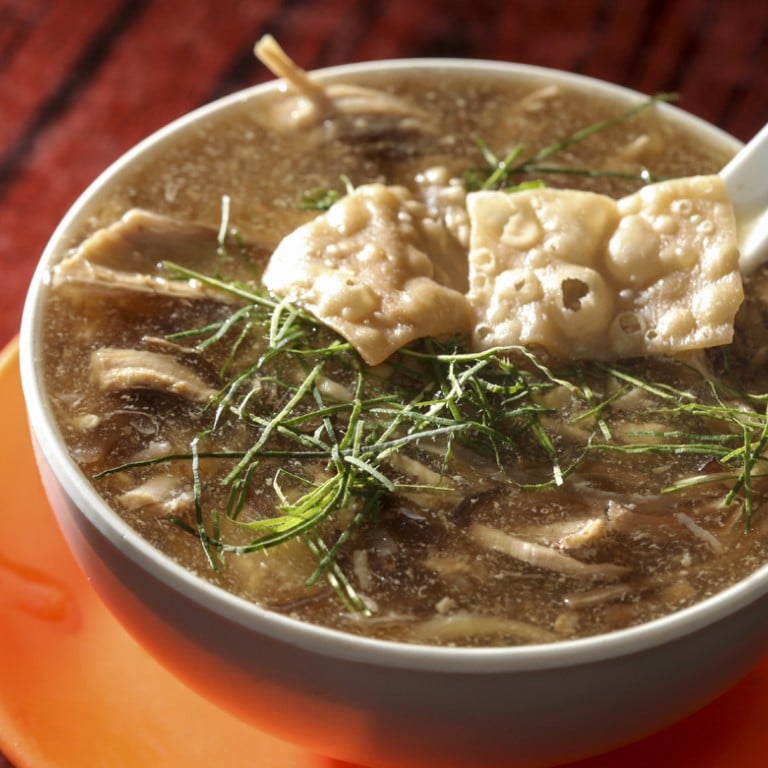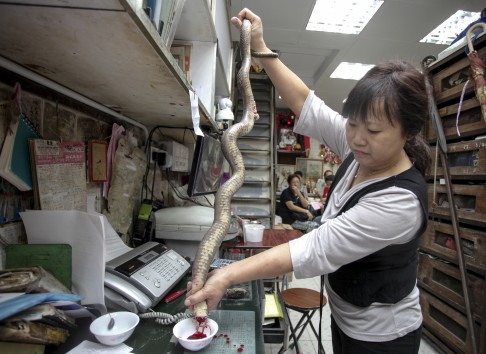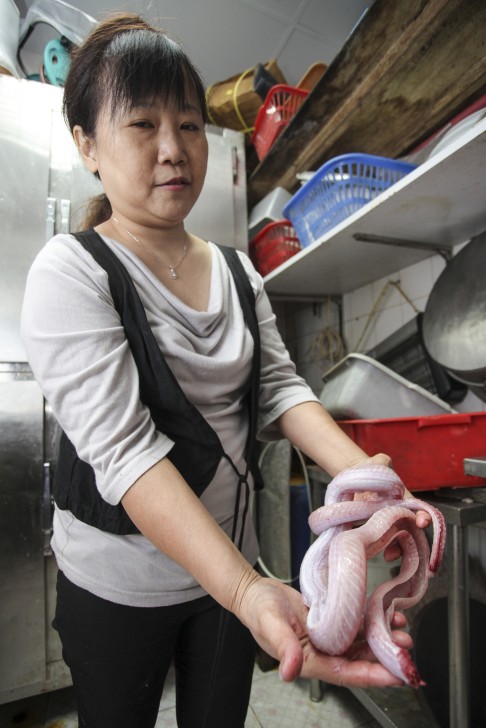
Seven places to eat a winter warmer, snake soup, in Hong Kong
It may not be everyone's idea of a winter warmer, but demand for snake soup has never been greater, writes Bernice Chan
a wooden drawer and deftly picks out a big snake for an elderly customer. She puts it in a cloth bag and lets him hold it to feel its weight. The customer's satisfied, so Chan takes the reptile from the bag and runs her thumbs along its body until she feels its gall bladder.

A quick incision and she retrieves a small sac which she puts in a small bowl. Then Chau disappears into the kitchen, returning with the decapitated snake and turning it upside down to squeeze some blood into the bowl. She pierces the gall bladder sac and mixes it with alcohol before giving it to the customer, who downs it quickly with a satisfied grin. "I like to have it, when it's in season," he says.
The gall bladder is said to improve virility, and to stop coughs.

This is Shia Wong Hip, a well-known snake eatery in Sham Shiu Po. There is a steady flow of customers all afternoon for not only fresh snake gall bladder, but also snake soup that Chau makes in the evening and simmers overnight. As winter approaches, locals like to eat dishes that warm their bodies, and snake soup is just the ticket.
Every batch is made with 30 catties of snake meat and bone, pork bones, two old chickens, Jinhua ham, black fungus, ginger, lemon leaves and mandarin peel. "The black fungus is for the blood, mandarin peel is to get rid of the gamey taste, lemon leaves for the smell," Chau says.
She encourages us to eat the soup while it's hot: "When the soup is cold, it has that smell. Eat it now." She serves herself a bowl, and in no time it's empty. "I want an encore," she says before downing another bowl.
In traditional Chinese medicine, snake is considered a warming ingredient that heats the body when it's cool outside. Snake soup is known for its healing properties, particularly promoting blood circulation, and easing the symptoms of arthritis.
"It's better than taking Western medicine because there are no side effects," she says.
Chau followed her father into the business when she was a teenager, and learned everything she could from the , or masters, he hired - one to manage the snakes, the other to make snake soup.

"When my father was out of the shop, I would learn how to handle the snakes, and how to skin them. When he came back and saw me handling them, he would tell me not to kill them, but I ignored him. I felt that if I was going to go into this trade, I had to learn everything," she says.
The snakes at Shia Wong Hip are shipped from China, Indonesia and Malaysia twice a week. Chau also supplies snakes to restaurants around the city. She doesn't feed the snakes - if they don't have much to eat their gall bladders are larger.
Every part of the snake is used, and she even sells the skins to factories to make belts and shoes. Her younger brother, who also works in the shop, is wearing a cream coloured snake belt and pouch around his jeans.
While Chau makes the soup, her brother cooks the snake meat. It's boned and chopped into chunks that are then deep-fried, braised, and sometimes cooked in claypot rice.
At the Hyatt Regency in Tsim Sha Tsui, Lo Kwai-kai, head chef of The Chinese Restaurant, orders his snakes from Shia Wong Hip, for dishes he makes during winter. He says the suppliers skin the snakes, take out the bones and then boil them together for an hour.
But the meat is still not tender enough for Lo, so he steams it for an hour more. He prepares the soup by julienning the ingredients for a more refined presentation. He adds sugar cane, an old chicken, pork, ham, mandarin peel, and lemon leaves to the soup mixture, and then white pepper.
"Snake on its own doesn't have much taste so you need to add other meats like chicken and pork," Lo says.
He fills the soup with ingredients, but it's a bit thinner than that available in local snake shops.
Lo says he's been preparing snake dishes since he started cooking in restaurants.
Fewer people are interested in dishes like stir-fried snake skin, but the demand for snake soup hasn't wavered.
Nest of vipers
170 Ap Liu Street, Sham Shui Po, tel: 2386 9064
Level 3 Hyatt Regency Hong Kong Tsim Sha Tsui, 18 Hanoi Road, Tsim Sha Tsui, tel: 3721 7788
24 Percival Street, Causeway Bay, tel: 2831 0163
30 Cochrane Street, Central, tel: 2543 1032
13 Hillier Street, Sheung Wan, tel: 2543 8032
84-90 Bonham Strand, Sheung Wan, tel: 2543 5919
Mei Fat Building, 41 Tai Wing Lane, Tai Po, tel: 2638 2663

